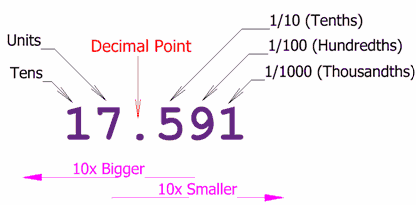Decimal Point
The decimal point is the most important part of a Decimal Number. It is exactly to the right of the Units position. Without it, we would be lost ... and not know what each position meant.Now we can continue with smaller and smaller values, from tenths, to hundredths, and so on, like in this example:

Large and Small
So, our Decimal System lets us write numbers as large or as small as we want, using the decimal point. Numbers can be placed to the left or right of a decimal point, to indicate values greater than one or less than one.| 17.591 | |
| The number to the left of the decimal point is a whole number (17 for example) | |
| As we move further left, every number place gets 10 times bigger. | |
| The first digit on the right means tenths (1/10). | |
| As we move further right, every number place gets 10 times smaller (one tenth as big). | |
Definition of Decimal
We sometimes say "decimal" when we mean anything to do with our numbering system, but a "Decimal Number" usually means there is a Decimal Point.
Ways to think about Decimal Numbers ...
... as a Whole Number Plus Tenths, Hundredths, etc
You could think of a decimal number as a whole number plus tenths, hundredths, etc:Example 1: What is 2.3 ?
- On the left side is "2", that is the whole number part.
- The 3 is in the "tenths" position, meaning "3 tenths", or 3/10
- So, 2.3 is "2 and 3 tenths"
Example 2: What is 13.76 ?
- On the left side is "13", that is the whole number part.
- There are two digits on the right side, the 7 is in the "tenths" position, and the 6 is the "hundredths" position
- So, 13.76 is "13 and 7 tenths and 6 hundredths"
... as a Decimal Fraction
Or, you could think of a decimal number as a Decimal Fraction.A Decimal Fraction is a fraction where the denominator (the bottom number) is a number such as 10, 100, 1000, etc (in other words a power of ten)
No comments:
Post a Comment